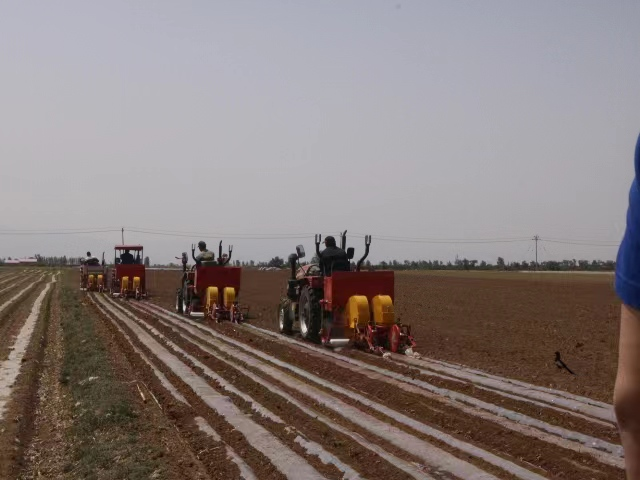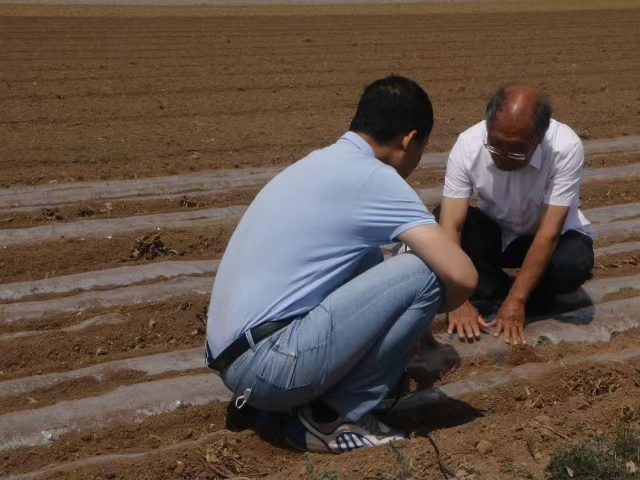Hybrid millet, known for its drought resistance, has small grains and weak sprouts, with poor topsoil penetration ability. This presents challenges in hilly regions (above 1600m elevation) characterized by ravines, thin soil, severe erosion, and significant water and soil loss.
Film mulching is a crucial practice in mountainous dryland agriculture. Currently, it is predominantly used in autumn for water conservation, benefiting seedling growth in the following year. This technique plays a vital role in preserving and strengthening seedlings, effectively enhancing grain yield and ensuring food security.
To successfully cultivate film-mulched millet, key aspects like seed selection, land preparation, and sowing must be well-managed. The film should be laid smoothly and tightly to prevent misalignment of sowing holes, affecting natural emergence, and to provide protection against wind lift.

Film mulching technology for hybrid millet
1) Adapt to Local Conditions, Select Suitable Millet Varieties
Under film mulching conditions, the suitable cultivation area for hybrid millet can be expanded to hilly slopes at elevations up to 1800m. In drylands, Zhang Hybrid Millet No. 3, 13, and 19 are appropriate, while Zhang Hybrid Millet No. 5 and 10 are suitable for areas with better moisture conditions.
2) Standardize Field Management, Optimize Individual Plant Growth Conditions
Zhang Hybrid Millet, a large-ear hybrid type with ear lengths up to 40cm and high tillering rates, requires cultivation management that emphasizes individual plant advantages, adhering to the principle of preferring sparser over denser planting. Based on years of experience, the suitable number of millet holes per acre is between 6500 and 10000. Fertilizer and water conditions should guide the planting density, with more dense planting in areas with better soil fertility and sparser planting in poorer fields as per practical experience.
During land preparation, it's essential to remove roots, straw, stones, and clods to prevent film damage during sowing, achieving a fine, fluffy topsoil with a firm lower layer.
For film selection, black films with a width of 80cm and a thickness of 0.012mm are recommended (black films have better suppress weeds, and facilitate photosynthesis due to increased scattered light, making them easier to recycle and remove). Alternatively, films with a width of 110 cm (60cm on the film and 50cm in the furrow) can be used, allowing 2-3 rows per film. When planting 3 rows, the spacing should be 20cm; for 2 rows, 30cm, with a hole spacing of 25cm. Each hole should be sown with 4-6 seeds, keeping 2-4 seedlings without thinning. The film should be laid when the soil moisture is adequate, covering the bottom moisture.

Zhao Zhihai (right), the chief expert at the Zhangjiakou Academy of Agricultural Sciences, providing guidance on mulching technology for millet.
3) Adopt Mechanized Sowing to Enhance Root Water Collection
Use a homemade duckbill-style seeder (modeled after a corn seeder). Two operators should pull the seeder along the direction of the film, sowing 2-3 rows at a time, covering 10 acres per day at a rate of 3 kg per acre. After sowing, the holes should be compacted with feet without covering them with soil. This creates a small pit at the sowing hole, increasing water collection up to 4-5 times the rainfall amount and more than doubling the root system. The sowing rate should be calculated based on the desired number of seedlings, germination rate, true hybrid rate, and thousand-seed weight. Additionally, a 30cm row-spacing specialized millet seeder can be used, with recent years favoring precision hole-sowing machinery with film covering, completing film laying, soil covering, and compaction in one operation. The sowing depth should be adjusted based on soil moisture conditions: shallower for good moisture and deeper for poor moisture.
Since 2009, "Zhang Hybrid Millet" has become a significant agricultural aid project in China's efforts to assist African countries, as part of the "South-South Cooperation". The promotion of film mulching technology can enhance the yield of hybrid millet in African developing countries, effectively alleviating food security issues.

For more information, please contact WFP China COE (wfpcn.coe@wfp.org)
Category
Film Mulching Technology for Hybrid Millet in Hilly Areas
Contributor
Film Mulching Technology for Hybrid Millet in Hilly Areas
Country
Technical Solution

